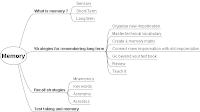
CRCB Chapter 3 Remembering what you read
Summary
Memory is the process of storing and retrieving information. You will have difficulty remembering what you read if you do not know the stages in the memory process, and purposely use strategies at each stage to ensure that newly learned information becomes permanently stored. The single most important aspect of memory is understanding what you are trying to remember. It is difficult, if not impossible, to remember concepts you do not understanding.
The three primary stages in the memory process are sensory, short- term memory, and long- term memory. Specific strategies you can use to enhance your sensory memory include the following: reading your text aloud, drawing pictures of the information you are learning, acting out a chapter in front of a mirror or an audience, visualizing information in your head, using your fingers to point to new words, and reading while riding an exercise bike. Chunking is an effective strategy for organizing and remembering new information so that it remains in your short- term memory long enough to transfer into your long- term memory. In order to permanently store new information you can use strategies such as organizing newly learned information, mastering difficult vocabulary, creating a memory matrix, connecting new information you already know, going beyond the textbook, reviewing, and teaching the new information to someone else. Recall techniques called mnemonics can help you retrieve information once it has been learned and stored properly. Some mnemonics introduced in this chapter are key words, acrostics, and acronyms.
No comments:
Post a Comment